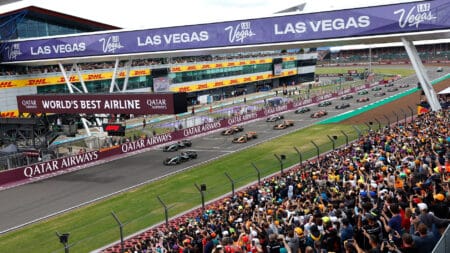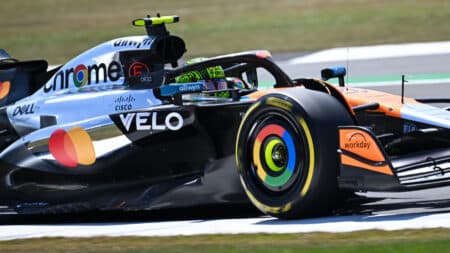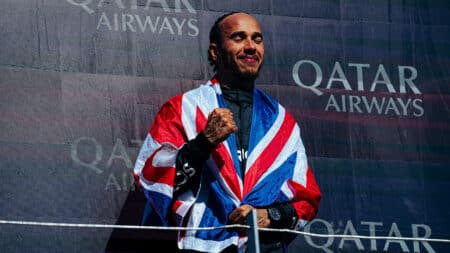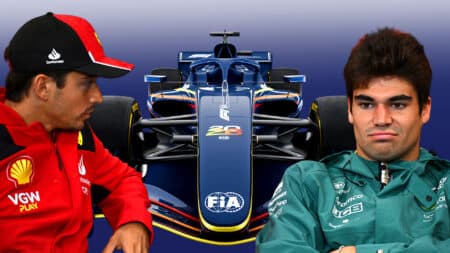
Tomorrow's F1 starting grid for the 2025 British Grand Prix
Max Verstappen will start on pole for the 2025 British Grand Prix after a brilliant last gasp qualifying lap. Here's how the starting grid looks for Sunday's race at Silverstone
Tomorrow five Formula 1 greenhorns will venture out on a ‘green’ parkland track Down Under to begin their Grand Prix careers for real. From sim to sink or swim.
Messrs Bianchi – yes, those Bianchis – Bottas, Chilton, Gutiérrez and van der Garde are this season’s fresh faces. Their average age is 23 – hence the freshness – but as is the way of the modern sport they will have packed heaps of experience into their kinderkartin’ careers and probably ‘invested’ the equivalent of Tuvalu’s GDP in the process.
Yet tomorrow it will dawn on them that all that has gone before counts for naught. Or at least it should. For the mainstream global audience cares not a fig about dominance in GP3 or handy performances in GP2 Asia, or about how much benefactors have spent to boost so-and-so to motorsport’s pinnacle.
The harsh reality of F1 expectation is: now get on with it.
How each of this nearly famous five deals with this pressure could set them up for the rest of their GP lives. Or permanently scar them.
First impressions count for a lot in F1 and are surprisingly accurate indicators.
In Melbourne in 2000, a just-turned-20 Jenson Button endured a qualifying struggle but raced beautifully while his Williams-BMW let him.
In 2001, after only 23 car races, Kimi Räikkönen finished sixth for Sauber having been found snoozing a mere 30 minutes before his GP debut. Those spots haven’t changed.
Also in 2001, debutant Fernando Alonso ragged a recalcitrant Italian design faster than it wanted to go.
In 2002, stubbly Mark Webber, in the first knockings of a now-or-never three-race deal, grabbed his chance by gritting it out to fifth place – in a Minardi! – while Felipe Massa qualified inside the top 10 for Sauber but got snagged by the usual first-corner pile-up at this track.
In 2007, a carefree Lewis Hamilton arrived to the manor born.
In 2011, Sergio Pérez caught the eye by one-stopping for Sauber – that kid’s different – while Force India’s Paul di Resta was indubitably competent (verging on anonymous) on his way to an inherited point.
And last year, you could barely slot a credit card between Toro Rosso’s new young bulls, but Daniel Ricciardo shaded Jean-Eric Vergne.
Away from opening-round debuts in Melbourne, stand-in Sebastian Vettel did all that was asked of him at BMW Sauber by finishing a super-composed eighth at Indy in 2007, and Romain Grosjean biffed his Renault’s front wing on the first lap of the ’09 European GP at Valencia.
Getting noticed instantly is an inexact science. Luckily for Michael Schumacher he managed it before his Jordan’s clutch cooked on the grid at Spa in 1991. Cocksure Eddie Irvine also managed it in a Jordan – and that was before his post-race verbals with a tightly wound Ayrton Senna at Suzuka in ’93.
It is also double-edged. Mario Andretti forever endeared himself to Colin Chapman by slapping a Lotus 49 on pole for his first GP, at Watkins Glen in 1968. A quarter-century later Mario’s son Michael – stranded on the grid by a clutch problem – wiped a wheel off his McLaren against a slower car after just four laps of the 1993 South African GP at the revived, reprofiled Kyalami. Such comparisons were a definite hindrance during the ragged remainder of the latter’s F1 misadventure.
Carlos Reutemann also announced his GP career from pole position, as did Jacques Villeneuve. (The latter would have won that 1996 Australian GP, too – the first to be held in Melbourne – but for a piffling oil leak.)
Nigel Mansell, in contrast, started his from the penultimate row, and would retire his Lotus 81B because of engine trouble after 40 laps of the 1980 Austrian GP. But not before he had (re)emphasised his fighting qualities by driving through the pain of petrol burns caused by a tipsy top-up on the grid.
So Messrs Bianchi, Bottas, Chilton, Gutiérrez and van der Garde, whatever else you do this weekend in Australia, don’t give up. Stefano Modena did – in Adelaide in 1987 – and the sport never completely forgot or forgave.
Until that point in his career the tousle-haired Italian had picked his moments perfectly. Runner-up in the prestigious Monaco Formula 3 race of 1986, he became that year’s ‘European champion’ by winning a one-off race at Imola. The following season he strung together a mature campaign to secure the International F3000 Championship title at the wheel of a Mike Earle-run March. There was absolutely no reason to think that Marlboro’s sponsorship of Stefano was misplaced.
His end-of-season F1 jaunt Down Under was meant to be the cherry on the cake for a future world champion.
He choked on it.
Brabham, on the slide after Gordon Murray’s departure to McLaren, should have been an ideal launch pad: still capable, but without any great expectation of success. And mid-grid respectability beckoned when Modena qualified, with some flair, 15th in its peaky BMW turbo-powered BT56.
His race, however, was a disaster.
Following an early pit stop because of flat-spotted tyres, he began to cramp. And after 31 laps of 82 he called it a day. Yes, it was hot in South Australia – but his reception from the powerbrokers was distinctly chilly.
He was consigned to EuroBrun for 1988 by way of ‘penance’ while Brabham took a sabbatical.
There were to be occasional flashes of style with substance – usually within the confines of a street circuit – at Brabham, Tyrrell and Jordan, but after finishing sixth in the latter’s unloved 192-Yamaha at Adelaide in 1992, the superstitious Modena departed virtually unheralded and with barely a backwards glance.
He had served five years for his Adelaide misdemeanour.
That’s the pressure I’m talking about.
Enjoy your debuts, guys.

Max Verstappen will start on pole for the 2025 British Grand Prix after a brilliant last gasp qualifying lap. Here's how the starting grid looks for Sunday's race at Silverstone

Austrian GP winner Norris went quickest at Silverstone during the Friday F1 practice sessions ahead of the 2025 British Grand Prix

Lewis Hamilton hadn't won in almost three years – and then produced a sensational victory at Silverstone 2024. James Elson explains why it was his best ever

As more drivers get a feel for the 2026 Formula 1 cars in simulators, concern is growing that the new regulations may sacrifice driving enjoyment in pursuit of technical ambition, as Mark Hughes reports